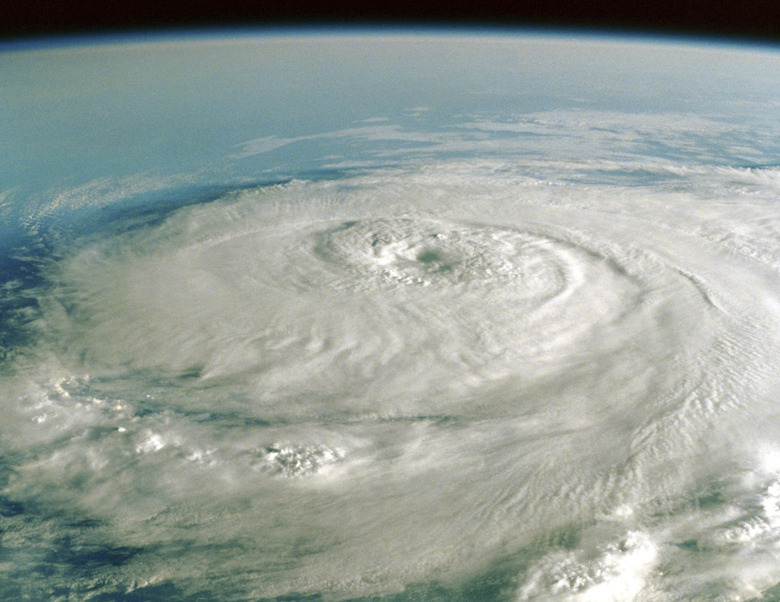Barometric Pressure & Hurricanes
Rotating storm systems that originate over tropical and subtropical oceans are called tropical cyclones. As a tropical cyclone gains intensity, it becomes a hurricane. Inside a hurricane, the barometric pressure at the ocean's surface drops to extremely low levels. This central low pressure draws in warm, moist ocean air, and thunderstorms swirl around the center of these massive storms.
TL;DR (Too Long; Didn't Read)
A particularly intense tropical cyclone is called a hurricane. Inside a hurricane, the barometric pressure at the ocean's surface drops to extremely low levels. As air is pulled into the eye of the hurricane, it draws moisture from the ocean and rises rapidly before condensing, cooling and releasing large amounts of heat into the atmosphere before falling and begins the cycle again. This refuels the hurricane, lowering the barometric pressure on the ocean surface. The lower the barometric pressure at the center of the storm, the stronger the hurricane, and vice versa. The Saffir-Simpson scale ranges from Category 1 hurricanes with a barometric pressure of greater than 980 millibars that cause minimal damage, to Category 5 hurricanes with a central pressure of less than 920 millibars.
Formation of Hurricanes
Formation of Hurricanes
When a tropical cyclone reaches hurricane strength, its low-pressure center is called the "eye" of the storm. Acting like fuel that feeds more energy into the storm, moisture from the warm water is converted to heat in the bands of rain that spiral around the eye. As air is pulled into the eye, it rises rapidly and then condenses, cooling and releasing large amounts of heat into the atmosphere before the air descends and begins the cycle again. This refuels the hurricane, lowering the barometric pressure on the ocean surface, which pulls more air in and upward, strengthening the hurricane. The lower the barometric pressure at the center of the storm, the stronger the hurricane, and vice versa.
Destructive Force
Destructive Force
Few other natural disasters cause destruction comparable to the destructive force of a hurricane. During their life cycles, each of these storms can expend as much energy as 10,000 nuclear bombs. With sustained wind speeds of 249 kilometers per hour (155 miles per hour) or more, intense rains and storm surges, hurricanes are capable of razing coastal areas. Hurricanes reaching Category 3 and higher are considered major hurricanes.
Classification of Hurricanes
Classification of Hurricanes
The Saffir-Simpson scale of hurricane intensity is based on measurements of wind speed, height of storm surges and central barometric pressure in millibars. The Saffir-Simpson scale ranges from Category 1 hurricanes with a barometric pressure of greater than 980 millibars that cause minimal damage, to Category 5 hurricanes with a central pressure of less than 920 millibars. Category 5 hurricanes are capable of causing catastrophic damage.
Major Hurricanes
Major Hurricanes
With only 892 millibars of central barometric pressure, the Labor Day Hurricane struck the Florida Keys in 1935 and was classified as a Category 5. Another Category 5 storm, with a central pressure of 909 millibars, Hurricane Camille made landfall in Mississippi in 1969. Hurricane Andrew, with a central pressure of 922 millibars, was also a Category 5 and struck southeastern Florida in 1992. Category 5 Hurricane Charley made landfall in Punta Gorda, Florida, in 2004 with a central pressure of 941 millibars. Although it was classified as a strong Category 3 storm, Hurricane Katrina at 920 millibars caused widespread devastation along many highly populated areas of the central Gulf Coast and had the third lowest central pressure ever recorded.
Cite This Article
MLA
Tides, Ocean. "Barometric Pressure & Hurricanes" sciencing.com, https://www.sciencing.com/barometric-pressure-hurricanes-22734/. 14 May 2018.
APA
Tides, Ocean. (2018, May 14). Barometric Pressure & Hurricanes. sciencing.com. Retrieved from https://www.sciencing.com/barometric-pressure-hurricanes-22734/
Chicago
Tides, Ocean. Barometric Pressure & Hurricanes last modified March 24, 2022. https://www.sciencing.com/barometric-pressure-hurricanes-22734/
